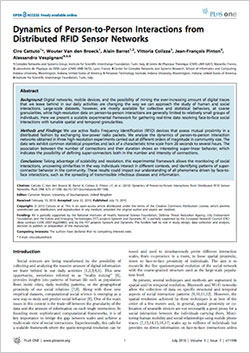Dynamics of Person-to-Person Interactions from Distributed RFID Sensor Networks.
Ciro Cattuto, Wouter Van den Broeck, Alain Barrat, Vittoria Colizza, Jean-François Pinton, and Alessandro Vespignani. PLOS ONE 5(7): e11596. doi:10.1371/journal.pone.0011596, July 2010.
 Background Background
Digital networks, mobile devices, and the possibility of mining the ever-increasing amount of digital traces that we leave behind in our daily activities are changing the way we can approach the study of human and social interactions. Large-scale datasets, however, are mostly available for collective and statistical behaviors, at coarse granularities, while high-resolution data on person-to-person interactions are generally limited to relatively small groups of individuals. Here we present a scalable experimental framework for gathering real-time data resolving face-to-face social interactions with tunable spatial and temporal granularities.
Methods and Findings
We use active Radio Frequency Identification (RFID) devices that assess mutual proximity in a distributed fashion by exchanging low-power radio packets. We analyze the dynamics of person-to-person interaction networks obtained in three high-resolution experiments carried out at different orders of magnitude in community size. The data sets exhibit common statistical properties and lack of a characteristic time scale from 20 seconds to several hours. The association between the number of connections and their duration shows an interesting super-linear behavior, which indicates the possibility of defining super-connectors both in the number and intensity of connections.
Conclusions
Taking advantage of scalability and resolution, this experimental framework allows the monitoring of social interactions, uncovering similarities in the way individuals interact in different contexts, and identifying patterns of super-connector behavior in the community. These results could impact our understanding of all phenomena driven by face-to-face interactions, such as the spreading of transmissible infectious diseases and information.
URL: http://www.plosone.org/article/info:doi/10.1371/journal.pone.0011596
PDF: http://www.plosone.org/article/fetchObjectAttachment.action?uri=info%3Adoi%2F10.1371%2Fjournal.pone.0011596&representation=PDF
BIBTEX:
@article{10.1371/journal.pone.0011596,
author = {Cattuto, Ciro and {Van den Broeck}, Wouter and Barrat, Alain and
Colizza, Vittoria and Pinton, {Jean-François} and Vespignani, Alessandro},
journal = {PLOS ONE},
publisher = {Public Library of Science},
title = {Dynamics of Person-to-Person Interactions from Distributed RFID Sensor Networks},
year = {2010},
month = {07},
volume = {5},
url = {http://dx.doi.org/10.1371%2Fjournal.pone.0011596},
pages = {e11596},
number = {7},
doi = {10.1371/journal.pone.0011596},
keywords = {SocioPatterns}
}

|
![SocioPatterns [logo]](http://www.sociopatterns.org/wp-content/themes/sp2/images/header_logo.png)
 Background
Background